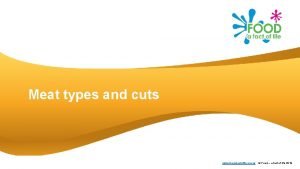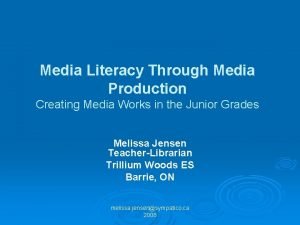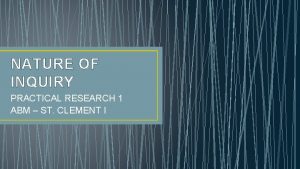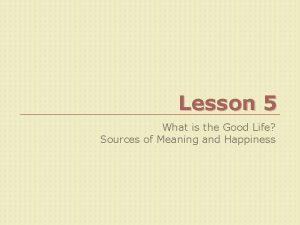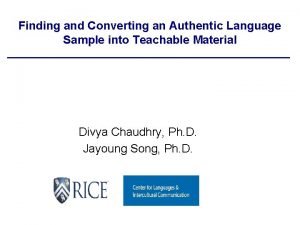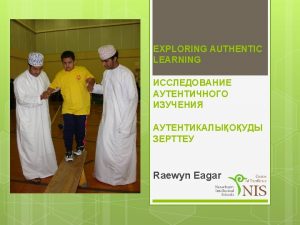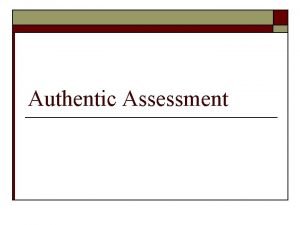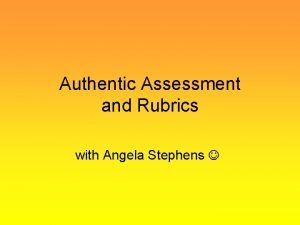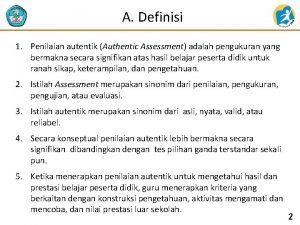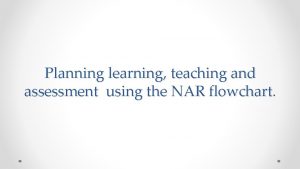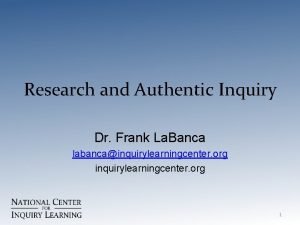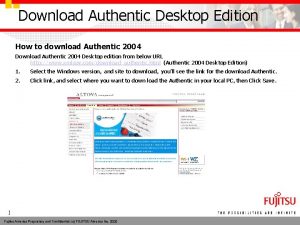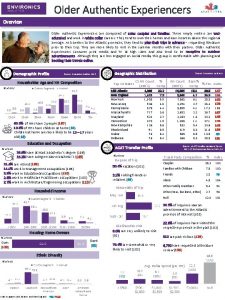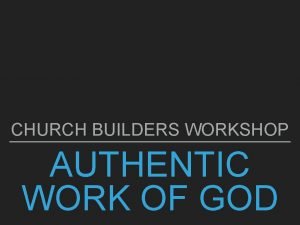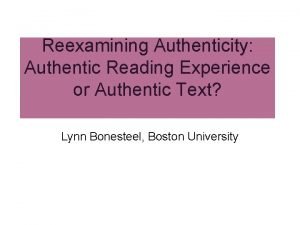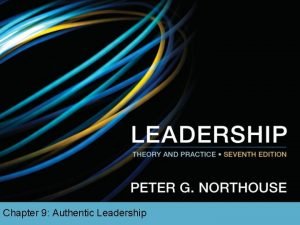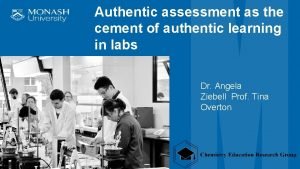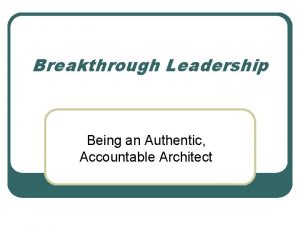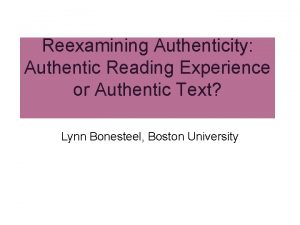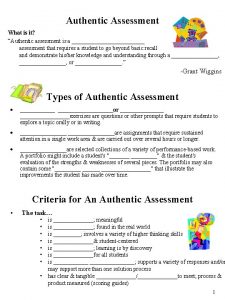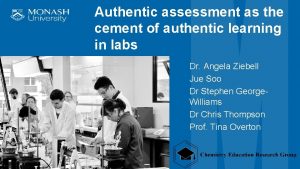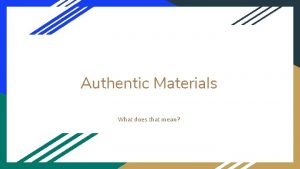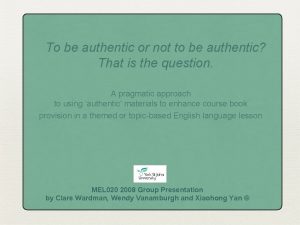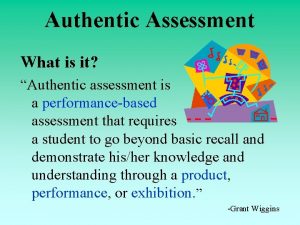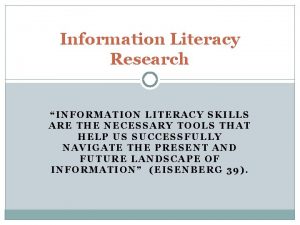Information Literacy Making Research Into Authentic Inquiry Prepared


















- Slides: 18

Information Literacy Making Research Into Authentic Inquiry Prepared by Robin Glowatz for NCTE Annual Convention, 2010

A Life Support System for information literacy….

Eisenberg’s Model for Developing Information Literacy: What skills do we want our students to learn? • Task Definition • Information Seeking Strategies • Location and Access • Use of Information • Synthesis • Evaluation *Is the research paper always the best way to teach these skills?

The Research Process as a cycle, not as a line: Realize you need some information or understanding to solve a problem 2. Identify a general topic or area of information 3. Investigate information on your general topic 4. Decide on a topic and focus it down 5. Collection: gather information 6. Work on a resolution to the problem 1. Fister, B. (1992). The research process of undergraduate students. The Journal of Academic Librarianship, 18(3), 163 -169.

The cycle… Identify your information need(s) Find information/record on NTKC Use the information to write bits of your paper or story… Ask questions— what do you need to know? What ELSE do you need to know? (NTKC) Look up background info Narrow down your question/topic

Redesigning how we teach research I-Journey project Designed by Penha & Roby and described in their article “Inquiry and Research Through the I-Journey Project” (2008). The I-Journey combines storytelling and research. Students write an original narrative. To make their stories realistic and believable, they must embed factual information collected from research. Authenticity: Research becomes inquiry Audience is no longer just the teacher—stories are more meaningful to students than reports or research papers. Penha, J. & Roby, M. (2008). Inquiry and research through the i-journey project. Classroom Notes Plus, 25(3). 1 -10.

What students started with: Students knew: how to find information to solve problems how to navigate some databases (such as i. Tunes) basic reading skills, like determining fact from opinion how to search the web using Google and Bing Students did not know: • how or why to cite sources • about copyright of images • how to evaluate and select a website • about academic databases (EBSCO, Omni. File, etc. ) and how to search them

As the project went on, students needed help: • Obtaining background info before selecting an appropriate topic • Specifying research questions • Information seeking strategies, location and access • Evaluating sources and information for usefulness and accuracy

What was new Embedded the research component within a context of story-writing (The I-Journey) Told from a 1 st-person point of view (can be any) Involves travel or journeying of some sort Must have enough basis in real life that it can involve research Advantages: Affective domain: students were more excited and less intimidated Authenticity: students had a real reason to care about their writing.

In addition to research skills, students also learned: Story Core components: writing a compelling narrative from Digital Storytelling by Jason Ohler Problem-Transformation-Resolution Point of view Needed to use a 1 st-person narrator Defining character/taking on a persona Non-objective writing, from a 1 st-person point of view

Frontloading skills is important! Identify several possible topics I-Journey framework: narrative form Drawing from Jason Ohler’s story core: Who are you? + Where are you going? + What is your goal? Practice writing from different points of view Learn and practice MLA citation style Learn about accessing information from sources: Online card catalog Website credibility Database searching Authentic practice: use these sources to explore multiple possible topics for their project

Need to Know Cards (NTKC) Skill: Directing and recording research Research questions: What things do you need to know to be able to write your story? As students planned their stories, they wrote down questions and topics that they needed to know more about. (See next slide: NTKC)

Notetaking format matters: Question-Answer form The information-seeking process became more purposeful and focused. research became inquiry helped students identify whether a source or piece of information was useful students worked toward the meaningful goal of finding information to fit their needs (rather than fulfilling an arbitrary requirement for the assignment)

Need To Know Cards RG 8 -1 NTK: How big was a T-Rex? Answer: 40 feet long and 15 -20 feet tall Source: A Students completed at least 50 NTKC throughout the project.

Source Cards RG 8 -1 Letter: A MLA citation: “Tyrannosaurus Rex. ” National Geographic Society, 2010. Web. 11 February 2010. Location: internet Students were required to use a minimum of 10 sources. For websites, they had to do an analysis of the site on the back of the card.

Outline Maps Planning the story helped students: break their topic into subtopics identify areas that needed to be researched (NTKC) Map: visual organization to the story Outline map: rough draft (at least 7 stops/events) Final map (with color, poster-size) due at the end of the project

Writing & Research Draft writing (in chapters): due in stages Frequent feedback Affective domain: project was broken into smaller, manageable chunks. NTKC due periodically—incremental deadlines DURING writing, not before! Cyclical process for research Research was an organic, intuitive process: students went and found information as they realized they needed it. Continuous feedback Peer editing every few chapters: students wrote for an authentic audience, and got feedback on story elements, writing style, and integration of facts Teacher feedback: expert advice and suggestions

Publishing Final Drafts Final Maps Presented at Academic Fair or at “Special Exhibition” for 7 th graders Presentations Needed to “present” their stories—NOT simply read them aloud Use final map and at least one “creative element” (such as a costume, prop, food, music, etc. )
 Similarities of media literacy and information literacy
Similarities of media literacy and information literacy What is media in mil
What is media in mil Example of people in media and people as media
Example of people in media and people as media What is inquiry in practical research 2
What is inquiry in practical research 2 List three examples of in-transit foodservice operations.
List three examples of in-transit foodservice operations. Casseroling
Casseroling Cyber literacy and digital literacy
Cyber literacy and digital literacy Poster making about media literacy
Poster making about media literacy Learning process that motivates you to obtain knowledge
Learning process that motivates you to obtain knowledge Ap research inquiry proposal form
Ap research inquiry proposal form Making inferences
Making inferences War making and state making as organized crime summary
War making and state making as organized crime summary A meaningful, authentic good life is based on
A meaningful, authentic good life is based on Authentic language examples
Authentic language examples Authentic learning
Authentic learning Authentic assessment definition
Authentic assessment definition Authentic assessment rubrics
Authentic assessment rubrics Authentic assessment adalah
Authentic assessment adalah Authentic assessment
Authentic assessment





